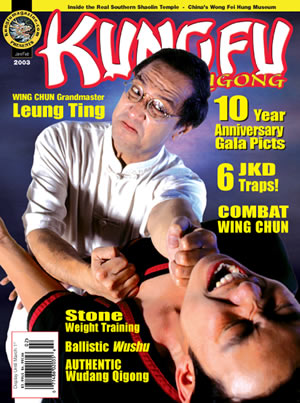|
|
|
Rock Solid!
by Jacob Fitisemanu with Master Cheng Tsang Lu |
|||||||||||||||||||||
 |
|||||||||||||||||||||
|
January/February 2003: Kung Fu Qigong magazine
"Rock Solid!" — Stone Lock weight training pumps you up. |
|||||||||||||||||||||
| Rock Solid! With all the modern workout programs and gadgets guaranteed to “pump you up,” many students of traditional Chinese martial arts have lost sight of much older body building techniques. In use long before contemporary free weights and gym machines, the Chinese stone lock has been part of traditional kung fu regimens since at least the Han Dynasty (206 BC-220 AD). The stone lock has been immortalized in kung fu training—evident in countless movies, pictorials, and martial texts—and its results are acclaimed through the tales of old masters and incredible feats. Though most kung fu rock exercises seem to target the torso and arms, training with stone locks and weight-balls helps build dynamic strength and endurance throughout the entire body. Swinging and pumping the weight of the stone builds muscle and bone strength, while maintaining one’s grip on the handle results in great forearm, wrist, and grip power. The synchronization of shifting stances and various swinging exercises greatly influences bodily coordination and balance. The endurance required also improves cardiovascular stamina and provides aerobic exercise. Origins of the Stone Lock It is well known that the ancestors of today’s kung fu systems were in active development prior to the Xia Dynasty (2000-1500 BC). Likewise, the basic Chinese security lock, which evolved into the peculiar kung fu training tool, had already been invented. Of course, the stone locks made for physique training were much heavier and larger than their spring-rigged counterparts. While traditional locks carved from rock can still be found today, some modern practitioners have enjoyed the same healthy results by using concrete or metal replicas. The stone lock is still relatively obscure in the West, but in many parts of rural Asia (and urban martial arts schools as well), lock-shaped weights and stones for muscle and stamina improvement are often seen. Stone training, which includes the large “Tai Chi ball” and tiger claw spheres, is not a popularly accepted means of muscle building. Most modern martial artists have opted for gym-style plates and bells because they are readily available and the general accepted means of bodybuilding in our modern society. Many practitioners, however, are discovering that traditional methods and tools can produce the unmistakable results that parallel modern weight training. Hooking up to an electro-stimulator may be the fast way, but it lacks the priceless link to a land far away and a time long ago. Shaolin Temple and Beyond From its ancient origins, the weight-lock soon found its way into the gates of Henan’s Shaolin monastery and subsequently spread to affiliated temples and military schools throughout the Chinese Empire. In the North, the Shaolin monks of Shandong Province retained and fostered the old routines introduced from Songshan. The Northern systems also innovated their own exercises and theories for strengthening the muscles, bones, and tendons which were passed through the generations to Grandmaster Yang Shao-Shan, and his monastic contemporaries in the Shandong temple. Following the Communist ascension in China, Monk Yang’s layman disciple, General Yin Chian-Ho, fled to Taiwan with the Nationalist Party he had fought for. In Taiwan, Shifu Yin’s mastery of Northern style Shaolin—complete with stone training routines—was inherited by Cheng Tsang-Lu. The young Lu rose in |
knowledge and skill to the promotion of Master and went on to win two National Championships and capture eight silver medals at the Taiwanese nationals. As a highly acclaimed and sought after teacher, Master Lu operated two respected Shaolin schools and acted in several martial arts films in Taiwan. |
||||||||||||||||||||
|
|||||||||||||||||||||
|
|
|||||||||||||||||||||